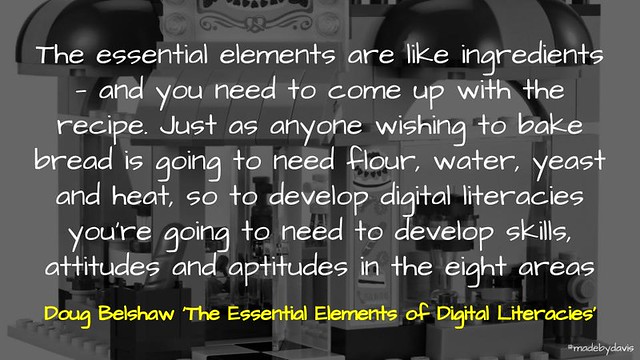
- “The Essential Elements of Digital Literacies” by mrkrndvs is licensed under CC BY-SA
Often when supporting teachers with the integration of technology, it is easy to start with a notion that people are beginners. This leads to a process of unpacking applications bit by bit. I wonder if rather than knowledge, the challenge associated with so called ‘beginners’ is confidence. This challenge though takes many guises. For some it is the confidence with the mechanics, while for others it comes back to purpose and intent. A useful framework for working through some of these idiosyncrasies is Doug Belshaw’s essential elements of digital literacies.
Rather than one singularly unifying notion of digital literacy, Belshaw argues that there are eight interlinked elements, each informing our understanding and application of digital literacies.

- “The 8 Essential Elements of Digital Literacies #digilit” by mrkrndvs is licensed under CC BY-SA
Thinking about an application like Hapara is interesting. It provides an added layer on top of GSuite, which allows teachers to organise and manage learning in the classroom. Using digital literacies as a lens provides an insight into a number of aspects to which a teacher may lack ‘confidence’.
- From a cultural perspective, Hapara posits that teachers are largely in responsible for creating the conditions for learning. Some teachers may have different pedagogical beliefs.
- Cognitively, it involves new ways of working. Although it may be more efficient, these are still habits to unlearn and relearn.
- Constructively, there is a blur between empowering students with the power to participate in actions and the dangers in excessively moderating learning using Highlights. Finding a balance can be challenging.
- From a communicative point of view, GSuite allows a number of ways to engage, Hapara provides the means to manage and moderate this within different cultural norms.
- Connecting with GSuite through the use of APIs, Hapara has the ability to both hinder and help the creative process, for on the one hand applications like Workspaces can be used to scaffold learning to support originality or to structure it in such a way that it could a construed as no more than a digital worksheet.
- From a critical and civic point of view, it is important to consider the why there is a need to manage learning and the consequences associated with such actions.
There is no one element that captures confidence and confidence in itself does not capture the full picture. Doug Belshaw’s elements provide a means of representing the assemblage of connections associated with technology. Something that Ben Williamson attempts in his own way in his work on Class Dojo. That being said, the answer is not to cover all elements each and every time in a checklist fashion. Instead, they provide useful provocation to go further in defining how we engage with technology.
So what about you? What strategies have you used to take the conversation around tech beyond the tool? As always, comments welcome.
If you enjoy what you read here, feel free to sign up for my monthly newsletter to catch up on all things learning, edtech and storytelling.
Taking Tech Beyond the Tool by Aaron Davis is licensed under a Creative Commons Attribution-ShareAlike 4.0 International License.

Mentions